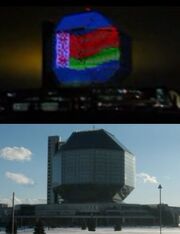LED lighting is already replacing incandescant lighting in vehicles, notably on brake lights. Producing much less heat than conventional bulbs they are more energy efficient - by around a factor of 4. Being less fragile, and less susceptible to vibration, they last longer, so they need replacing less often.
- Ultra bright LEDs will increasingly be used in household lighting for similar reasons.
- The colour of LED arrays will be tunable. The basic method is to have two colours of LED red and green, in the same capsule, and to pulse the leds with varying pulse-widths to adjust level of green and level of red, giving colours in between, including yellow.
- With processor power becoming ridiculously cheap, and with increased awareness of the psychology of how lighting affects mood, complex lighting effects that affect mood will become the norm.
- Lighting doesn't have to be fixed, it can be a substance or "sand" or something similar.

Minsk library
above: animated;
below: during the day
All sorts of surfaces, from skin (work is ongoing on implantable animated tattoos), to clothing to surfaces of buildings will become animated. For example, the walls of The National Library of Belarus [1] [2] [3] make a giant video display (watch video).
Environment[]
- In Ireland plans are being discussed to introduce a punitive tax on incandescent light bulbs in order to encourage more energy efficient bulbs. The tax on incandescent light bulbs, it is suggested, will be close to the cost difference between such bulbs and long-life low power bulbs.
- Prompted by an initiative by Germany, the EU is discussing plans to ban incandescent light bulbs completely. This is probably unworkable, though an EU-wide tax is likely.
CFL[]
- The current market share of CFL bulbs in the United States is about 6 percent, up from less than 1 percent before 2001. But that compares dismally with CFL adoption rates in other wealthy countries such as Japan (80 percent), Germany (50 percent) and the United Kingdom (20 percent). Australia has announced a phaseout of incandescent bulbs by 2009, and the Canadian province of Ontario decided to ban them by 2012.[4]
- 2007 May 10 The light bulb has been running out of friends recently. California and Canada have decided to ban the sale of incandescent bulbs by 2012. Australia is banning them in 2010. The European Union is looking at banning production of the bulbs. A U.S. Senate committee is working on a proposal that would phase out the light bulb in 10 years.[5]
- 2007 June 6 European lamp makers on 5 June proposed a phase-out of the least efficient lamps in homes by 2015. The Commission reacted favourably to the industry initiative, while Greenpeace criticised the timeline as being too long. Industry proposes that the phase-out takes place in two-year stages, starting with a ban on 100 Watt bulbs in 2009 and finishing with a ban on 25 Watt bulbs in 2015. As part of its proposal, the industry is also pushing for strict "market surveillance mechanisms" to ensure proper compliance across the sector. [6]
Next-gen lamps[]
Plasma light bulbs can be 10 times as efficient as old incandescent bulbs and twice as efficient as LEDs.
Links[]
- CEELite flat surface lighting
- Flat lightbulb
- Quantum dot lighting
- Gallery of LED lighting for buildings
Reference[]
- An even brighter idea, Economist - about replacing lightbulbs with LEDs.
- Future of lighting (in Russian)
